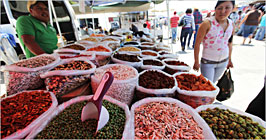Markets Evoke Memories of Mexico

There are roughly 7,000 Mixtec people in greater Madera. The Mixtec farmworkers are recent arrivals, having migrated first within Mexico, where they picked cotton or cut sugar cane. Photo by Jim Wilson/The New York Times.
August, 2011
Every Sunday, Juan Enriquez, a former farmworker from Mexico, shows off his culinary art, sculpturing sweet white meat from young coconuts with a knife and briskly sprinkling it with salt and lime.
"It is better than working in the fields," Mr. Enriquez said of his new job as a vendor at the Madera Flea Market. "Here at least there is shade."
In the Latino communities along Highway 99, the artery of the San Joaquin Valley, the grand tradition of the Sunday flea market - fly swatters, car parts, plastic Betty Boop purses and all - has been transformed into the famed open-air bazaar or tianguis that is a fixture of daily life throughout Mexico.
Madera is a mecca for the state's estimated 120,000 indigenous Mexican-Indian farmworkers, many of whom are from Oaxaca and speak a pre-Columbian language called Mixtec. And its Sunday flea market is a colorful world-within-a-Latino-world, recreating the weekly gatherings around hundreds of village plazas. Upwards of 6,000 marketgoers banter over cucumbers laced with fiery pico de gallo, buy CDs of Mixtec bands and scout the best prices for pápalo, an aromatic green that grows wild in the mountains of Mexico. Music shifts like living radio from vendor to vendor, from the Beatles to Chilenas con violin, lilting traditional sounds. It is a backdrop to the array of sombreros, tomatillos, copal incense for Mass and simulated ostrich ranchero boots.
Story by Patricia Leigh Brown/New York Times


